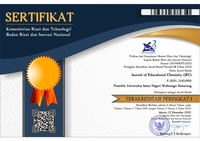Cybercrime: An Empirical Study of its Impact on Society- A Case Study of Chemistry Students
DOI:
https://doi.org/10.21580/jec.2024.6.1.17010Keywords:
chemistry students, cybercrime, suspicious links, websitesAbstract
Cybercrime is considered one of the most significant crimes effecting people and society. Computer network are involved in this type of crime, with various hackers participating. Through such crime, identities and much information of the victims are stolen. Many students, especially international students and young individuals, fall victim to this fraud. This study focuses on raising awareness among people to avoid scammer’s link or unknown websites that seek to obtain their information. This will be achieved by organizing different questionnaires by teaching staff at one of the Iraqi Universities in this field, to be answered by undergraduate and postgraduate students. The statistical analysis conducted on this group showed that students are more educated and aware, making them less likely to fall victim to these types of crime. This is a result of the knowledge and skills these students acquired through technology and various sessions and training at universities or other resources.
Downloads
References
Barclay, C. J.. (2017). Cybercrime and Legislation: a Critical Reflection on the Cybercrimes Act, 2015 of Jamaica. Commonwealth Law Bulletin, 43(1), 77-107.
Bele, J. L., Dimc, M., Rozman, D., & Jemec, A. S. (2014). Raising Awareness of Cybercrime--The Use of Education as a Means of Prevention and Protection: ERIC.
Britt, C. L.. (1994). Crime and Unemployment Among Youths in the United States, 1958‐1990: A Time Series Analysis. American Journal of Economics and Sociology, 53(1), 99-109.
Button, M., Nicholls, C. M., Kerr, J., Owen, R. J. A., & criminology, N. Z. j. o. (2014). Online Frauds: Learning from Victims Why They Fall for These Scams. Australian & New Zealand Journal of Criminology, 47(3), 391-408.
Cantor, D., & Land, K. C.. (1985). Unemployment and Crime Rates in the Post-World War II United States: A Theoretical and Empirical Analysis. American Sociological Review, 50(3), 317-332.
Das, S., & Nayak, T. J.. (2013). Impact of Cybercrime: Issues and Challenges. International Journal of Engineering Sciences & Emerging Technologies, 6(2), 142-153.
Donalds, C., Barclay, C., & Osei-Bryson, K.-M. (2022). Cybercrime and Cybersecurity in the Global South: Concepts, Strategies and Frameworks for Greater Resilience: London: Routledge.
Levi, M., & Pithouse, A. (1992). The victims of fraud. In Unravelling Criminal Justice: Eleven British Studies. London: Springer.
Melick, M.. (2003). The Relationship Between Crime and Unemployment. The Park Place Economist, 11(1), 30-36.
Mokha, A. K.. (2017). A Study on Awareness of Cyber Crime and Security. Research Journal of Humanities and Social Sciences, 8(4), 459-464.
Vasileiou, I., & Furnell, S. (2019). Cybersecurity Education for Awareness and Compliance. Hershey: IGI Global.
Vincent, N. A. (2017). Victims of Cybercrime: Definitions and Challenges. In Cybercrime and its Victims. London: Routledge.
Waschke, M. (2017). Personal Cybersecurity: How to Avoid and Recover from Cybercrime. London: Springer.
Yadav, H., Gautam, S., Rana, A., Bhardwaj, J., & Tyagi, N. (2021). Various Types of Cybercrime and its Affected Area. Data Mining and Information Security: Proceedings of IEMIS 2020, Volume 3.
Downloads
Published
How to Cite
Issue
Section
License
The copyright of the received article shall be assigned to the journal as the publisher of the journal. The intended copyright includes the right to publish the article in various forms (including reprints). The journal maintains the publishing rights to the published articles.
Authors are permitted to disseminate published articles by sharing the link/DOI of the article at the journal. Authors are allowed to use their articles for any legal purposes deemed necessary without written permission from the journal with an acknowledgment of initial publication to this journal.

This work is licensed under a Creative Commons Attribution-NonCommercial-ShareAlike 4.0 International License.


